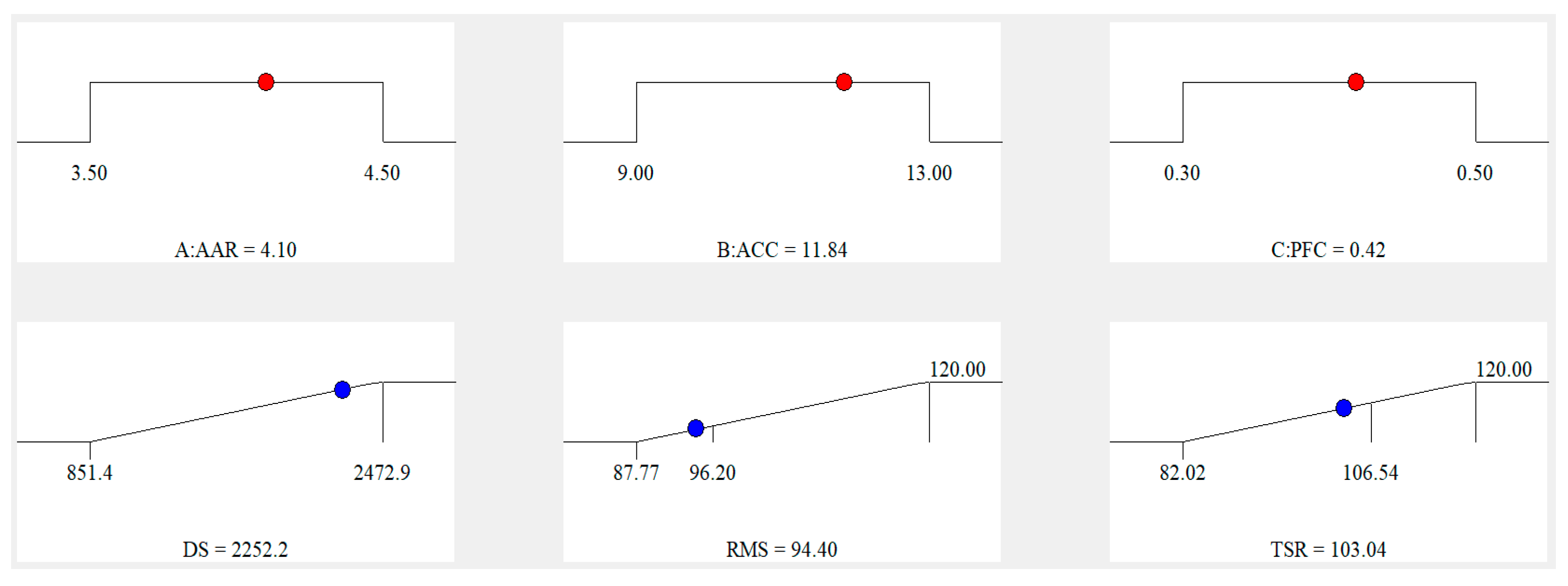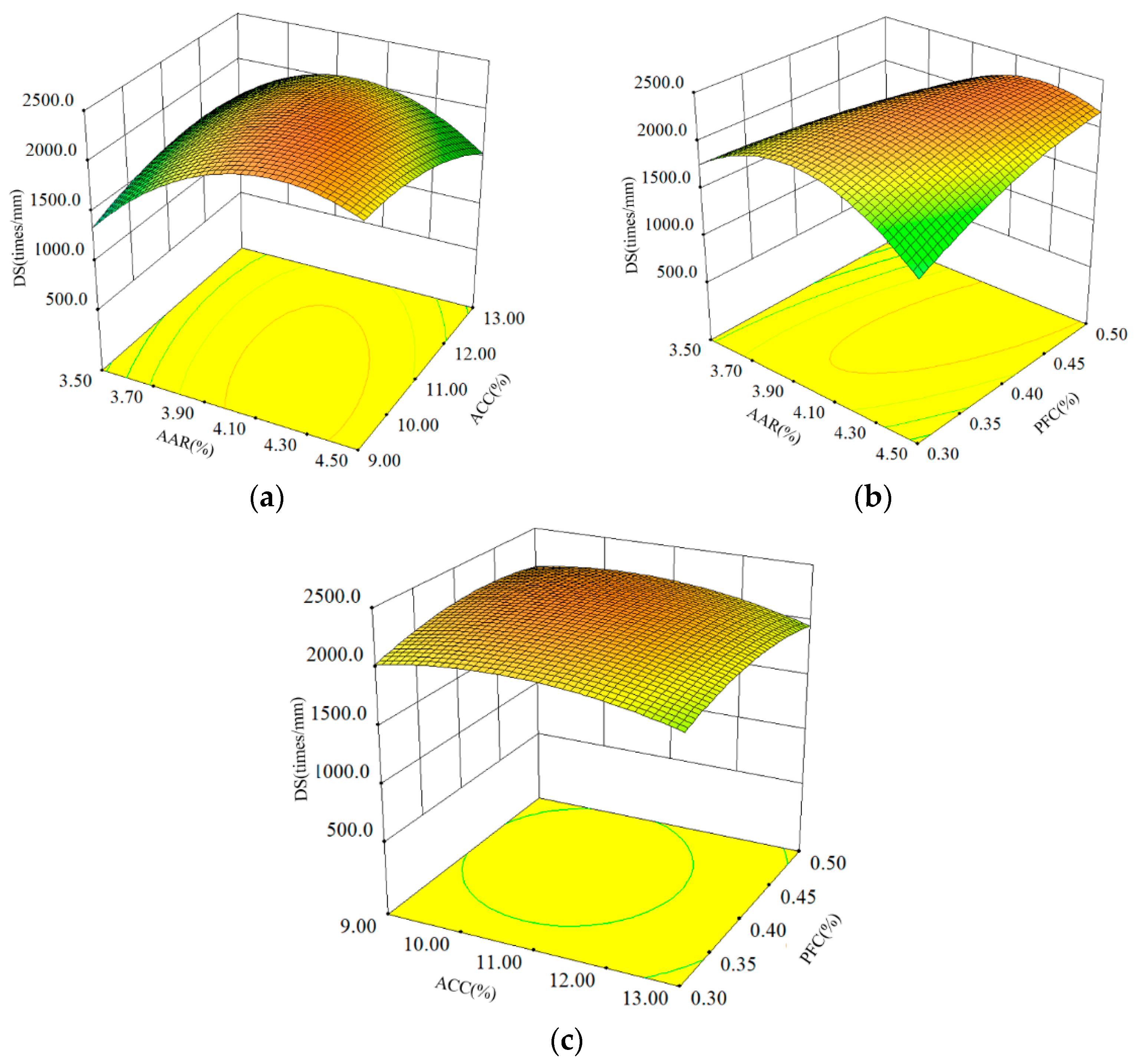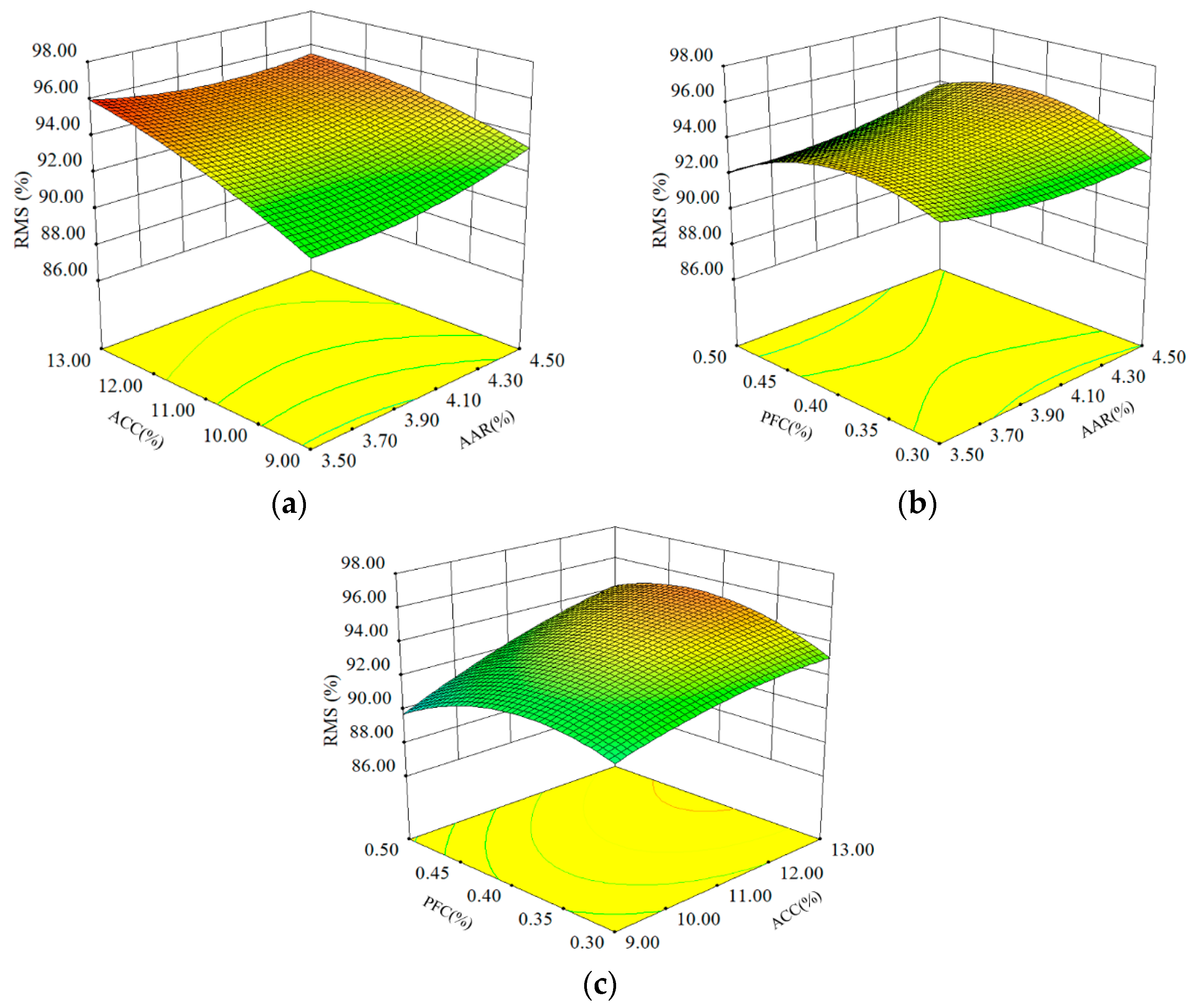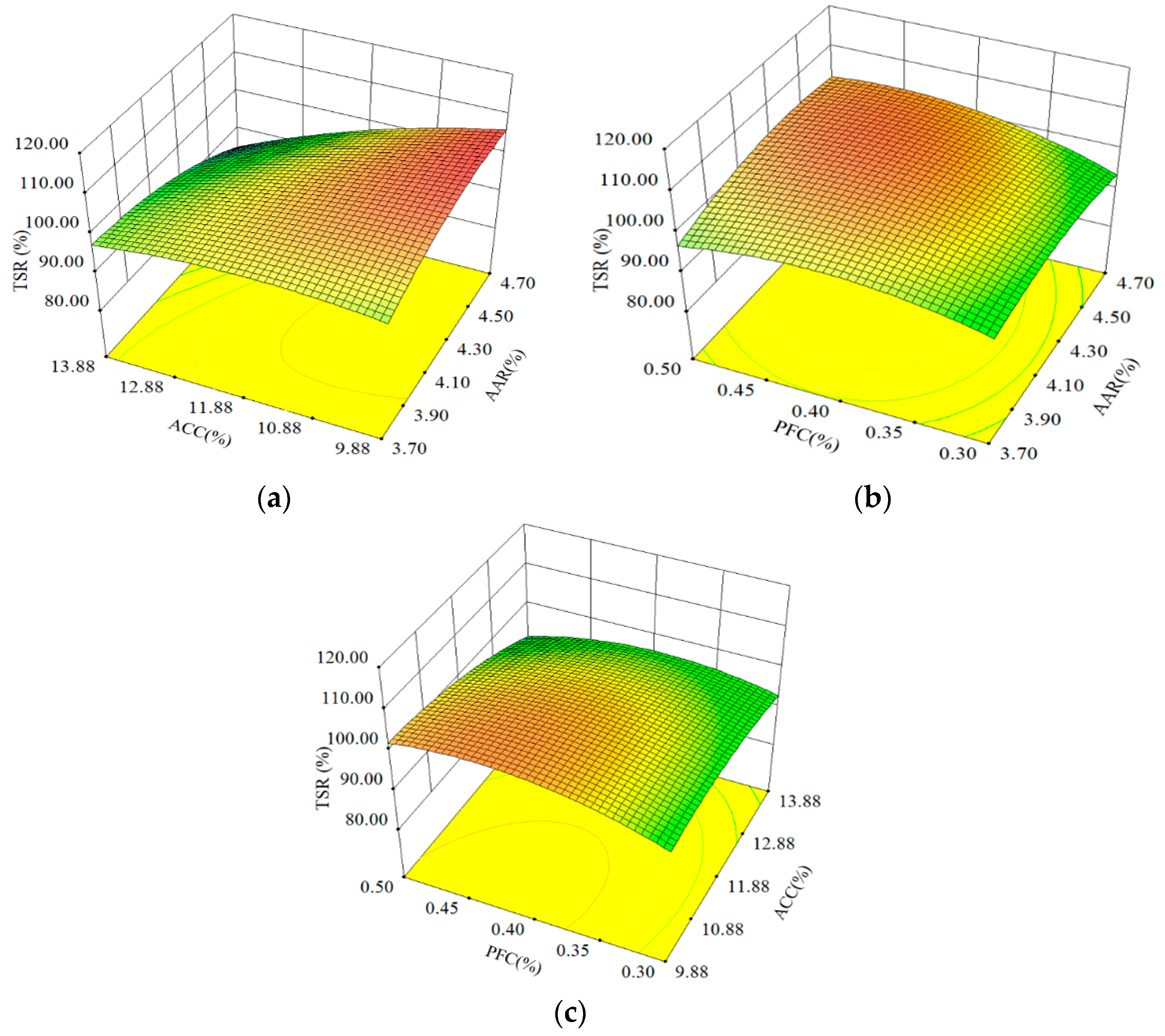1. Introduction
Asphalt pavements in different climatic regions have various performance requirements for asphalt mixtures [
1,
2,
3,
4]. In order to comprehensively analyze the performance of asphalt mixtures, it is important to have a thorough comprehension of the meteorological attributes pertaining to the specific geographical region in which the road is situated. Asphalt pavements in hot–humid areas are often influenced by high temperatures, rain, and other natural conditions and are prone to rutting, and potholes in the process of use, which result in the overall functionality and durability of the asphalt pavements being significantly compromised. Therefore, researchers have occasion to conduct research on methods that would enhance the properties of asphalt pavements to be suitable for hot–humid areas.
Current research shows that there is a certain correlation between the roadway effectiveness of modified asphalt mixtures and the proportion parameters (externally modified amount and asphalt aggregate ratio). The results presented by Hong R.B. showed that when the polyester fiber (PF) content was 0.4% and the gangue powder replacement rate was 50%, the interaction between asphalt, PF, and gangue powder caused asphalt mixtures to exhibit excellent low-temperature anti-cracking properties [
5]. Zhao X.W. studied the effect of Sasobit and Deurex on the characteristics of crystalline tetra-alpha-ethylene-modifying asphalt mixes and found that 4% Sasobit +2% Deurex was the optimal amount for asphalt mixtures, and they had better mechanical properties and economic benefits [
6]. P. Ahmedzade found that when the asphalt content was 5.3%, asphalt mixtures made from 8% tall oil bitumen and 6% styrene–butadiene–styrene had the best physical and mechanical properties [
7]. Yang B. found that the best performance of large-particle-size-modified asphalt mixtures was achieved at elevated temperatures when the asphalt aggregate ratio was 3.23% and the rock asphalt content was 20% [
8]. Zhai R.X. showed that 5% nano-CaCO
3 and 4% SBR exhibited exceptional resistance to rutting deformation under elevated temperatures [
9]. In the study conducted by Gong Y.F., it was observed that the composite-modified asphalt mixtures retained their pore properties in optimal water stability even after undergoing freeze–thaw cycles with a 3.9% basalt fiber, 5.1% nano-TiO
2/CaCO
3 content, and 5.67% asphalt aggregate ratio [
10]. Yan K.ZH. found that 15% waste tire rubber and 4% amorphous polyolefin was the optimal content for achieving the best performance for asphalt mixtures [
11]. Zhang H.T. concluded that asphalt mixtures modified using 4% SBS and 15% rubber were appropriate for asphalt pavements located in high-temperature, heavy traffic regions, and asphalt mixtures containing 4% SBS and 3% SBR were deemed suitable for cold–humid regions [
12]. Cheng Y.CH. found that diatomite and basalt-fiber-composite-modified asphalt mixtures were more resistant to seasonal permafrost than the base asphalt mixtures in areas with freeze–thaw cycle damage [
13]. Zhe H. demonstrated that a 2% thermoplastic polyurethane and 6% amorphous poly-alpha-olefin-modified asphalt mixtures had better rutting and moisture resistance than base asphalt mixtures [
14]. Therefore, optimizing the mix design of modified asphalt mixtures to adapt to the climatic conditions in hot–humid regions has a beneficial impact on the enhancement of asphalt pavements’ resistance to high temperature and water damage.
A common method for creating a mix ratio design for externally mixed and modified asphalt is to first determine the optimum asphalt aggregate ratio of asphalt mixtures under different externally mixed mixtures using the Marshall test, and then to carry out mixture performance tests such as the wheel tracking test, low bending test, immersed Marshall test, and freeze–thaw cycle test. Asphalt mixture proportion parameters with better overall performance are then obtained according to the results of the various performance tests for asphalt mixtures under different external mixing amounts. Nevertheless, this method usually requires a large amount of experimentation, resulting in the squandering of both resources and time. Thus, researchers have conducted relevant research on convenient methods applicable to the optimization of the design parameters of asphalt mixture ratios, such as response surface design and multifactorial orthogonal design. Fan T.T. used the central composite circumscribed design (CCC) method, a type of response surface design, to optimize the design parameters of polyester fiber and anhydrous calcium sulfate whisker composite modified asphalt mixtures with better low-temperature properties [
15]. Ahmed I. Nassar utilized response surface design to optimize the mixing ratio of an emulsified asphalt mixture [
16]. Taher B.M. used response surface design to optimize the content of asphalt and polyethylene terephthalate in asphalt mixtures, and the results showed that the Marshall properties of the modified asphalt mixture achieved the best performance after adding 5.88% asphalt and 0.18% polyethylene terephthalate [
17]. Wei Y. revealed the relationship between the bone glue/polyurethane content and the properties of an asphalt binder using response surface design, and the optimal contents were 6.848% bone glue and 2.759% polyurethane [
18]. Cheng Y.CH conducted a comprehensive study on the optimization design and testing of a diatomite- and basalt-fiber-compound-modified asphalt mixture. Through the application of grey correlation grade analysis, the ideal mixing scheme was determined. The experimental findings indicated that the incorporation of 14% diatomite, 0.32% basalt fibers, and 5.45% asphalt aggregate resulted in the improved high- and low-temperature performance of the asphalt mixture [
19]. Du J.CH. studied an approach for conducting grey relational regression analysis on hot-mix asphalt [
20]. Lyu ZH.H. conducted an analysis of the performance of cold recycled mixtures. Additionally, an objective theory was optimized for the material content based on a multi-index-weighted grey methodology [
21]. Slebi Acevedo, C.J. used multi-standard decision-making technology to study the functional and mechanical properties of polyolefin-aramid fiber and hydrated-lime-modified porous asphalt mixtures [
22,
23].
Therefore, this article conducts a study on the optimization of mix proportion design and hydrothermal-performance-influencing factors of the asphalt mixture with the addition of ACSW and PF. Three mix ratio design parameters (namely, ACSW content, PF content, and asphalt aggregate ratio) and three hydrothermal performance evaluation indexes (namely, dynamic stability, retained Marshall stability, and tensile strength ratio) were selected. The central composite circumscribed design (CCC) and grey correlation grade analysis (GCGA) were used to perfect the mix ratio design characteristics of modified asphalt mixtures in hot–humid areas. The effects of the design parameters on the hydrothermal performance of the asphalt mixtures were explored; meanwhile, the correlation degree between the design parameters and the hydrothermal performance indexes was evaluated using GCGA.
4. Conclusions
In this article, a multi-objective optimal proportioning design of an anhydrous calcium sulfate whisker and polyester fiber composite modified asphalt mixture was carried out using the central composite concatenation design and grey correlation grade analysis methods. The effects of anhydrous calcium sulfate whisker content, polyester fiber content, and asphalt aggregate ratio on the hydrothermal properties of the asphalt mixture were investigated using rutting tests, retained Marshall tests, and freeze–thaw splitting tests. The conclusions are as follows:
- (1)
The central composite concatenation design and grey correlation grade analysis methods are suitable for the quantitative study of the optimum mix ratio design of anhydrous calcium sulfate whisker and polyester fiber compound modified asphalt mixtures in hot–humid areas.
- (2)
The proportions of 11.8% anhydrous calcium sulfate whisker, 0.42% polyester fiber, and 4.1% asphalt aggregate can produce an asphalt mixture with better hydrothermal performance.
- (3)
The asphalt aggregate ratio has a greater influence on the hydrothermal performance, polyester fibers mainly affect the moisture susceptibility, and anhydrous calcium sulfate whiskers mainly affect the high-temperature properties of the asphalt mixture.
Recommendations: Feasibility research on the application of calcium sulfate whiskers as a renewable solid-waste resource in pavement materials has just begun. This paper studied the influence of calcium sulfate whiskers on the high-temperature deformation resistance and water damage resistance of an asphalt mixture and puts forward an optimization method for the mix ratio design of a modified asphalt mixture based on hygrothermal performance. However, the influence and mechanism of calcium sulfate whiskers on the low-temperature crack resistance and durability of asphalt mixtures, as well as the optimization method of the mix ratio design of modified asphalt mixtures considering physical and mechanical properties and road performance, need to be further studied.











